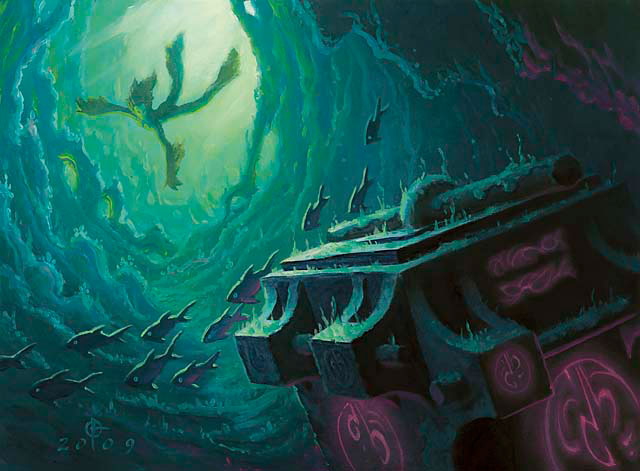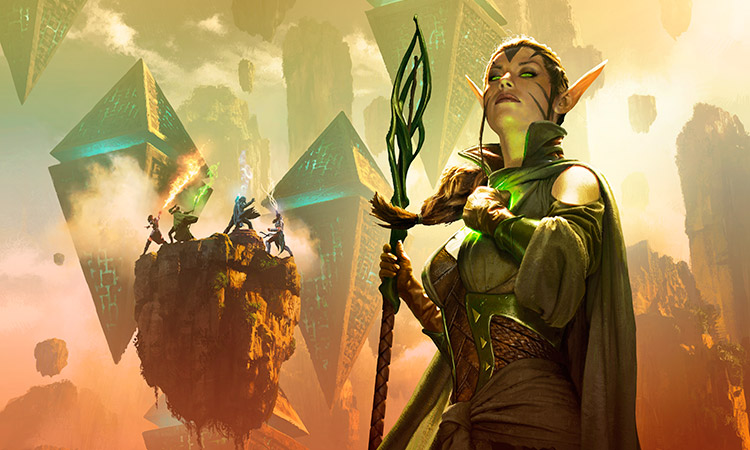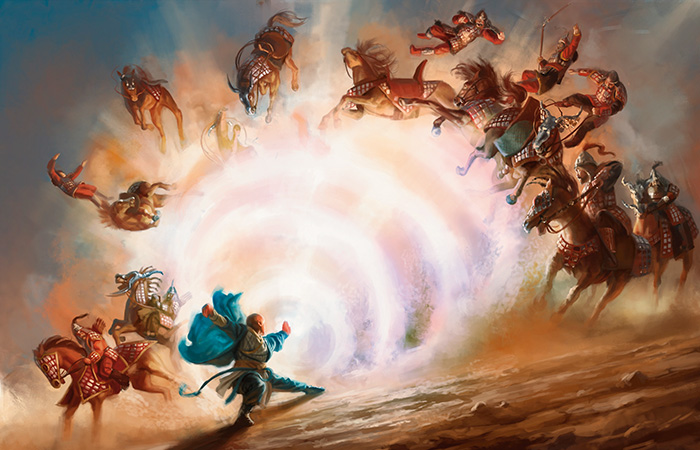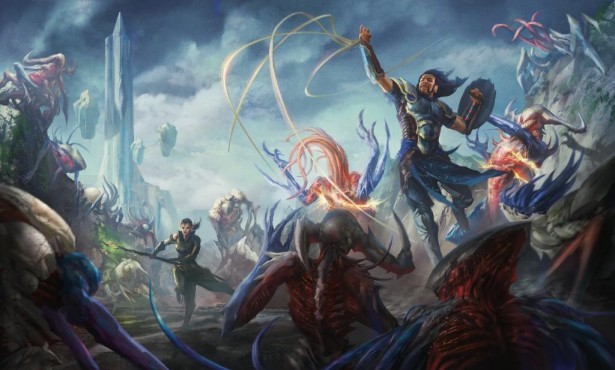Well, the boys and I got together and jammed some very casual games of Magic this past week. It was glorious! We just sat around and slung card board around until it was far too late and enjoyed every moment of it. However, one problem with playing casual Magic is that it takes so darn long. Multiplayer games take ages because everyone is apprehensive about going out and attacking and leaving themselves vulnerable to some sort of counter attack by the rest of the table. The game turns into plenty of defensive posturing and very little else going on. In 5 hours of Magic we played 2 complete games. 2 Games! That just isn’t very much. There are lots of house rules that one can play, but I think I may have found something even easier to help bust up that board stall and speed up the game.
My solution is a maligned Mythic from Oath of the Gatewatch that seemed like it could almost make the grade in Constructed, but sadly has fallen by the wayside. I’m talking about Inverter of Truth which is a devastating 6/6 flier for 4 mana. With those sorts of stats you need to respect it, but there is a drawback. The drawback is that when Inverter of Truth enters the battlefield you must exile your library, and your Graveyard becomes your Library. In most situations this means that you lose a big portion of your deck, which can hurt. If this is done too early you can run yourself out of cards in a real hurry and basically forfeit yourself the game because you just don’t have the tools you need to get the win. However, if you use this judiciously, Inverter of Truth can be cast to great effect.
Imagine a situation where you have already cast a number of really good spells. Perhaps you cast some removal spells, a couple of really strong creatures, maybe a reanimation spell or two and some other goodness. What it means is that once you cast Inverter of Truth you get all those spells back and this time you won’t be drawing land in between good spells. That sounds actually really appealing. Who wouldn’t want to draw only spells that ensure you play action?
The other side effect that this card does is that it changes the mental position of the player who cast Inverter of Truth. We played two games and both times that Inverter was cast the player who cast it immediately adopted a more aggressive position because they no longer had the luxury of playing for the attrition based resource battle. The player who just cast Inverter needs to get down to business of using his Library (that yields only gas) and this efficient 6/6 flier to pressure the table and bust up the board stall that is so typical in multiplayer Magic. It is often this shift in just a single player that can push the whole table away from stalling out and reinforcing their position and then move everyone into a frantic race to not get run over. This single person shifting into an aggressive posture is all the game needs to pick up speed and to cause itself naturally, without the addition of house rules or other adjustments to the game itself, to come to a very rapid conclusion. It is a very effective trick to get a game kicked up into high speed.
In addition to the very intriguing and powerful card, Inverter of Truth gives us a very budget friendly creature to add to decks playing Black. At a mere $0.75 this is a bargain for a card that dramatically changes the face of the game. Some might argue that it doesn’t feel “Mythic” enough, but the effect on the game is immediate and profound suggesting that naysayers may be mistaken. The next time you sit down to ponder what changes to make to your deck, do not discount Inverter of Truth because it can provide a much needed infusion of something truly interesting into the game.
*Editor’s note: Prices are subject to change according to the whims of the multiverse.
There is no doubt that Kaladesh is a casual player’s paradise. The set just offers so much in the way of fun mechanics and innovative ways to get more out of your cards. However, to my eye the real element that has been built into Kaladesh that sets it apart from other sets is all the built in ways to “blink” your guys for value. Not since Avacyn Restored have we had so many ways to blink stuff and have draft chaff look so good.
Wispweaver Angel is the perfect example of a ridiculous limited card that has a huge payoff in casual games to allow you to blink all sorts of goofy things. It is a long way from being Restoration Angel, but the fact remains that using Wispweaver Angel is going to have some similar effects around the kitchen table. Pair the angel up with Panharmonicon and you have yourself some extremely powerful synergies to grab the attention of Casual players.
If blinking your stuff is proving an issue, or you’re looking for another way to get some value from your ETB triggers, Kaladesh has another totally innocuous card in the form of Aviary Mechanic that can now play alongside Kor Skyfisher and Emancipation Angel as some of the best ways to re-play your value creatures. Let me assure you, these are the sorts of commons casual players look for and love to abuse. Whether it is returning a Scry Land for the free Scry, or a Siege Rhino, or something slightly more degenerate, these simple but effective additions to casual decks can really help push them in the right direction. Look for them and see if you can squeeze them in because you might be pleasantly surprised.
Well, that’s what we’ve got for this week. Thanks for stopping in for a read and be sure to stop by next time for another Casual Encounter.
Bruce Gray
@bgray8791

Shadows Over Innistrad (SOI) is right around the corner and I couldn’t be more excited. We’re almost through spoiler season and the set is already overflowing with fantastic cards. Diametrically opposed from Battle for Zendikar (BFZ) – the first set of the block immediately preceding it – SOI is poised to introduce powerful new cards for aggro, control, midrange and even combo archetypes across all formats. To top it off, the flavour of this set is absolutely phenomenal, as almost every card seems to tell it’s own story. There’s just so much to be excited for, the 2nd of April pre-release can’t arrive soon enough.
Spoiler season is a lot of different things to a lot of different players. The more competitive players are trying to deduce which cards will become format staples and help define or redefine deck archetypes. The Commander players are looking for new tricks to replace old cards in preexisting decks as well as looking forward to new legendary creatures. Collectors are eager to speculate on the next potential break out card.
Then there’s players like me: Players who look at the new cards and fantasize creating new, interesting and/or silly decks. Players who see one card and say: “I don’t know what deck that goes into yet, but I’m going to build it.” Players who want to play the game in a way that no one was expecting. With that in mind, I’d like to talk about a few new cards that I believe are particularly exciting to build around. They may not be the most powerful or expensive cards from the set, but they sure are cool.
I’m a huge fan of cards that callback to older cards. BFZ’s Zulaport Cutthroat being a callback to Avacyn Restored‘s Blood Artist, for example. With that in mind, I think my favourite card of the set spoiled thus far has to be Odric, Lunarch Marshal.
I returned to Magic right as the original Innistrad was being released. At that point, I was very much a casual kitchen table player: I was always looking for cheap, cool cards that I could throw into a deck to challenge my brother with. When I happened upon Concerted Effort, I couldn’t understand why this card was as financially cheap as it was. I loved anthem effects and the idea of my entire army growing in powers and abilities as more and more creatures joined my side of the battlefield was a mind-blowing concept.
I quickly learned why Concerted Effort wasn’t as powerful as I initially believed it to be. It was a turn 4 “Do Nothing” card: a term used for cards that don’t really do anything when they enter the battlefield when you critically need them to be doing something (especially on turn 4). What made Concerted Effort worse was that it required a critical mass of creatures to function optimally which made you susceptible to board wipes. Lastly, it was a “Win More” card: a term used for cards that only affect your game when you are already in an advantageous position against your opponent(s). Concerted Effort won’t help you bounce back if you’re behind on board state, lacking blockers and facing down your opponent’s mob of creatures. But if you were ahead? Oh boy, were you going to win big. Regardless of its faults, I loved the potential buried in Concerted Effort.
While still suffering from a few of the problems listed above, Odric, Lunarch Marshal does solve a number of them. He still requires a critical mass of creatures which in turn leads to potentially overextending your hand, meaning you will be putting sadness on the stack when your opponent plays their board wipe. That being said, he solves the problems of being a “Do Nothing” and/or “Win More” card. As a 3/3 creature himself, Odric advances your board state by being a creature that can attack or block rather than an enchantment that can do neither. His ability can also kick in the turn he comes into play if you play him pre-combat as opposed to Concerted Effort which only becomes relevant at the beginning of the next upkeep. The biggest drawback with Odric’s ability this time around is that it leaves your army very vulnerable during the first main phases of each turn.
Most pro players will tell you that Odric isn’t a great card. There’s too much set up required and there are too many drawbacks involved. All I can see is an incredibly fun card. In more casual environments, playing a White Weenie aggro deck with him being at the top end of my curve seems amazing. Prioritizing creatures with double abilities would be the key to building a solid Odric deck. Playing a Kytheon, Hero of Akros on turn 1 into Knight of Meadowgrain turn 2 into Misthoof Kirin turn 3 into Odric turn 4 will give your entire team First Strike, Lifelink, Flying, Vigilance and the ability to become Indestructible if Kytheon‘s ability is activated pre-combat. I don’t know about you, but that sounds absolutely devastating.
Keep in mind when building an Odric deck that I believe the most important ability to bestow unto your army is Flying. Archetype of Imagination in Born of the Gods Limited single-handedly won games by granting evasion to your entire team. Odric can endow evasion two turns earlier provided you have a creature with Flying somewhere in the first 3 turns. In Standard, I feel like Odric can top end a deck with Kytheon for Indestructible, Topplegeist for Flying, Consul’s Lieutenant or Knight of the White Orchid for First Strike, Hidden Dragonslayer for Lifelink, Topan Freeblade for Vigilance and Aven Sunstriker for Flying and Double Strike.
While we’re on the topic of critical masses and over-extensions, it’ll come as no surprise that I absolutely love “Lord” cards.
So named because older cards referred to them as such in the type line (rather than naming the actual creature type), “Lord” creatures refer to creatures that give a boost or bonus to creatures of a similar nature. In the above case, Elvish Champion provides a +1/+1 bonus and grants the Forestwalk ability to all Elf creatures.
While Dark Ascension provided us with more traditional style “Lord” creatures within the world of Innistrad, Shadows Over Innistrad is playing around with what a “Lord” creature can be. Instead of a static +1/+1 boost with an additional bonus, the “Lords” in SOI are synergistic with their favoured creature types in more innovative and interactive ways.
Of these “Lords,” Falkenrath Gorger seems like the most interesting while also the most difficult to build around. Taking advantage of discarding cards is not something that’s done often in Magic. Here is a “Lord” that wants you to build a deck that forces you to discard creatures, while at the same time, having enough mana to pay for the discarded creature’s converted mana cost. Presently, the only Vampire that can take full advantage of discarding cards is Vampire Hounds, a card originally printed in Exodus. If we look away from Vampires, though, Avaricious Dragon in Standard and Liliana of the Veil in Modern help us with discarding our own cards. Other cards I feel might work as a foundation for a discard/Madness decks are Pack Rat (I get a rat and a Vampire?! Sign me up!) and Tibalt, the Fiend-Blooded. Will Falkenrath Gorger finally make Tibalt amazing?
No. No, he probably won’t… But it’ll make your games hilarious.
The “Lord” I’m most excited for is Silverfur Partisan. Aside from having a great name and stunning art by Izzy, Silverfur Partisan is a “Lord” for one of my favourite niche creature types: Wolf (which is ironic since, in real life, I’m terrified of dogs). Wolves are a neat little tribe in Magic with a lot of fun, older cards that can make use of a Wolf “Lord.”
Mayor of Avabruck // Howlpack Alpha is a more traditional style Wolf “Lord” that synergizes well alongside Silverfur Partisan. Master of the Wild Hunt also has synergy with both Mayor of Avabruck and Silverfur Partisan (although you’d have to find ways to protect Silverfur Partisan, as he would be forced to fight if you activated Master of the Wild Hunt‘s ability). Wren’s Run Packmaster and Wolf-Skull Shaman might lead you toward of a more Elf/Wolf tribal deck. Whichever deck you decide to build for yourself, don’t forget to include my favourite flavour combination: Enchanting a Silverfur Partisan with a Raised by Wolves. While it may not trigger his token making ability, giving Silverfur +3/+3 and two wolf buddies to back him up is pretty awesome.
That’s it for our first look at some of the neater cards of Shadows Over Innistrad. I hope you enjoyed it and that it inspired you to put together some fun decks you can play with your friends. As always, if you liked what you see here or have any questions, feel free to leave a comment in the Comments section below!
JP Vazquez – Optimum Jank

Welcome to the world of Magic: The Gathering. A world filled with nuanced heroes in troubled circumstances, interesting monsters that are often more than they appear to be, captivating worlds begging to be explored and fantastic spells that bend the reality of those worlds. Somewhere in that mix, there just happens to be a pretty fun card game to collect as well. Exciting, isn’t it?
Whatever the reasons may be that brought you to this game, there are always a number of questions that plague new, returning, or even experienced players. Whether it be about card evaluation, deck piloting strategy, or simply how to introduce the game to a new player, there’s no end to the number of queries this game can create.
Although there’s an endless amount of content by pro players much better at the game than I am to answer questions about critical meta-game strategies, there’s far less content out there for the more casual players. The ones trying to figure out if now is the best time to come back to the game after a long hiatus. The ones who have no idea what to do with all the draft cards they’ve amassed. The ones who want to introduce the game to their friends but aren’t sure how best to present it to them. The ones who like to bring their silly combo deck to Friday Night Magic. If this sounds like you or one of your friends, I have a feeling we’ll get along swimmingly.

Getting started (or re-started) with Magic can be a daunting and/or overwhelming experience. There are a lot of rules. There are a lot of experienced players. But most of all, there are a lot of cards. The sheer number of cards alone can often astound newer players. Some of the most frequently asked questions I get when explaining the game to prospective players are: “How do you remember what all the cards do? Did you have to study them all? Does every player know what all these cards do?”
Here’s a little secret: Most players don’t know what every card does. Certainly, there are players who do know a large percentage of the cards, but most don’t know every single card printed in the history of the game. A large majority of the time, you’ll only need to know a handful of cards at a time (depending on which format(s) you’re currently playing) to follow along. The longer you play, the more time you’ll spend talking about cards. After a while, you’ll notice that you’ll hear about particular cards more than others. Eventually, you start to learn based on this repetition. There’s no need to study the entire catalog of Magic cards before you start playing and there’s no need to memorize all the strategies, archetypes or lingo before you get going. All you need is a pack of cards and a buddy who’s willing to guide you through your first few games and you’re good to go.

Now that we’ve covered what you don’t need to do, the next question becomes: Which cards do I need to collect or need to know about in order to play? Technically, the answer to that could be any and all cards in the history of Magic as long as your deck meets the format’s minimum card requirement.
I can see you panicking again. Don’t worry, we can fix this too.
Magic‘s most popular format is something called “Casual Magic,” also known as “Kitchen Table Magic” because of the mental image that most casual players play around the kitchen table. When playing Casual Magic, all you need is a deck of cards and some buddies to play. The reason this is the most popular version is that it has the least rules and regulations. At this level of Magic, people are just reading the cards and playing the game as they see fit. There’s no banlists nor format requirements that allow certain cards and prevent others cards from being in your deck.
Inevitably, there will come a time when you might want to optimize your deck. Or challenge yourself by playing against more difficult or focused decks rather than the random cards you’ve thrown together for kitchen table games. Most players will recommend Friday Night Magic (FNM) events at their local game stores as the next logical step. While this may be a solid step for returning players who already have experience with the game, I’ve seen a number of new players get very nervous about Drafting or playing against expensive, finely tuned Constructed format decks.
Frequently overlooked by enfranchised players of the game, there are other options available to newer players which will allow them to step up a their game before venturing in the realm of FNM. A format I love recommending to newer players is what I call “Intro Pack Magic.”

Whenever a new Magic set is released, Wizards of the Coast (the folks who make the Magic cards) release “Intro Packs.” These are 60 card pre-constructed decks that (currently) come packaged with two booster packs. These decks and boosters predominantly contain cards from the current and/or immediately preceding set of cards. As an example, at the time of writing, the newest set released is Oath of the Gatewatch. Oath of the Gatewatch Intro Packs contain cards found in OGW (the abbreviation for Oath) and Battle for Zendikar (BFZ); the set that preceded OGW.
These decks are exactly what you would expect from something called an “Intro Pack;” they are a means to introduce a new player to the newest set and to Magic itself. These are not meant to be tournament competitive decks: They will be crushed by top tier decks if played against one. That being said, they’re usually solidly balanced to play against each other. If you can find a friend who’s interested in playing “Intro Pack Magic” with you, here’s how it’s done:
Why are we waiting to open them, you may ask? By playing with your deck straight out of the box, you’ll hopefully have developed an understanding of your Intro deck and what it’s trying to do. These booster packs will have a lot more meaning to you now. Not only do you get to see sweet new cards and hopefully open an expensive rare, you’ll be looking at all the cards through the filter of your Intro deck. You’ll start to evaluate which cards would work well with your deck, which cards might actively work against it and which cards might not have any importance either way. Perhaps you’ll find a card or two that you’ll want to add to your deck. Great! Try to take one card out of your deck for each card you add in. Replay your decks with your new cards and see how that goes. You can continue making modifications to your deck as you see fit.
By focusing on this smaller initial pool of cards, you’re already starting to develop and learn basic skills you’ll be needing as a burgeoning Magic player: You’re learning such concepts as card evaluation, deck construction, the management of limited resources and the ability to quickly learn new cards found in a particular Standard set.
Intro Pack Magic can be taken a step further within your playgroup if, at the end of every week, you each agree to buy a booster from the set your Intro Pack is from. Add the cards you like from your new booster to your deck. Over time, you’ll acquire more cards for your collection, have a uniquely tuned deck that you’ve played with friends in a non-competitive environment, and will develop skills needed if you do decide to make that leap to FNM Draft or Constructed.

I hope you enjoyed today’s column! The topic of how to start (or jump back into) Magic is one I often see pop up on Magic forums and websites, so I was excited to address it here. In future, we’ll be looking at various other ways to play Magic which will hopefully appeal to the Casual and Competitive alike. If you liked what you see here or have any questions, feel free to leave a comment in the Comments section below!
JP Vazquez – Optimum Jank

The anticipation is mounting! In just a few short days we will be getting our first chance to play Battle for Zendikar and I’m pretty excited. There are some amazing new cards in this set, and some terrific reprints that got some slick new art. It looks like there are going to be some bonkers new additions to just about every format, including Casual Kitchen Table Magic. Today I’m going to go through my Top Ten cards to bring to your next Casual Kitchen Table Magic game night and spice things up. Let’s get down to business.
10. Common Land Cycle ( Sandstone Bridge, Skyline Cascade, Mortuary Mire, Looming Spires, Fertile Thicket ). This common land cycle doesn’t look super spicy, but let’s be real, any time you can play a land card and have an effect that is normally created by a spell you have something that is deceptively powerful. There will be loads of decks looking to pick these up to replace just a regular basic land card, and the extra ability is always a solid trick. Now, let’s talk about how to abuse these (i.e. get more than one activation). In a Kitchen Table world you are constrained only by your card pool and the rules you and your friends have established, so finding fun ways to take advantage of these should be easy. Let’s start with the “Karoo” lands or “Bounce” lands from Ravnica. These were reprinted in Modern Masters 2015 making them pretty readily available and an easy way to get more than one activation of these. Emancipation Angel or Kor Skyfisher, or even Pearl Lake Ancient are also some of my favorites and could easily get you additional activations. Going a little more in the the history of Magic, Soramaro, First to Dream would be hilarious.
As if just getting the value off these lands wasn’t enough, don’t forget this set is packing Landfall meaning that you are very likely to net all sorts of value off of just playing these lands. That makes these things even more appealing. The nice part is that you will usually be pleased to see these guys, regardless of what stage of the game you’re in. Keep your eyes peeled for these small, but significant, additions.
9. Noyan Dar, Roil Shaper: What isn’t to like about this guy? He’s a 4/4 for 5 mana which is a pretty reasonable rate to start and you will not feel ashamed to run him out. His size also makes him surprisingly robust and able to tussle if the need arises. However, what is truly gross is his ability. You get free +1/+1 counters on your lands every time you cast an instant or sorcery…and in Blue and White isn’t that what you want to do anyways? I can well imagine EDH decks premised on this guy or just jammed in there for value. However, what I think might be truly busted is playing Jeskai and slamming this guy and Zada. Cast your instant on Zada, copy the spell a bunch of times, make a pile of Elementals, attack for the win…or something like that. Yes, that is magical Christmas land, but it’s fun to dream. I’m kind of excited to see this guy and try him out.
8. Omnath, Locus of Rage: I don’t know what to do with this guy…but I like the fact that Omnath is getting a reprinting, and this time he’s pissed. I haven’t got a clue how good he will be, or any deck built around him using elementals as a centerpiece, but this guy sure looks unhappy and ready to kick some butt. All he really asks of you is to play your land and benefit from an army of 5/5 tokens, but that feels a little too simple. Omnath makes the list because of his unbridled anger…and big scary tokens. For those of you out there with RTR block cards still kicking around, time to dust off those Populate enablers..
7. Catacomb Sifter: This guy is among my favorite cards in the set and the art is insane. That is spectacular art! The colours and contrast really stand out and makes this thing look super frightening. But enough about the art. This 3 mana creature packs 3/4 worth of power and toughness across 2 bodies which is a very good rate. I know I play casually, but I also really like efficient creatures…they help me get to the much less efficient but fun part of my deck! This is exactly the sort of thing I want to do. However, there is still more. This packs the Scry 1 ability that Reaper of the Wilds packs just because…umm…value? This is a very strong card and I can’t wait to get my hands on some of these guys and ride the Value Train.
6. Halimar Tidecaller: How is this NOT a rare? Can you just imagine pairing this with Noyan Dar and making FLYING land creatures? Wow. And you even get to bring another relevant spell out of your graveyard to replay and get yet ANOTHER land creature. Sure, it is a bit of a build around, but if you can successfully build around it this looks amazing! For a paltry 3 mana this feels as if it has been pushed to try and push an elemental theme…and I’m taking the bait! I can almost taste the Elemental Deck…Brews to come!
5. Defiant Bloodlord: Ok folks, this makes the list because you now have Sanguine Bond attached to a 4/5 flying body. This gives those janky “life gain” decks you see around the Kitchen table yet another win condition and NOW it gets to attack too! I’m just dreaming of casting this and Feed the Clan to maximum effect. The interaction between this and Gray Merchant of Asphodel seems like it could be potent too. All in all, there will be lots of ways to abuse this around the Kitchen Table so you had better buckle down.
4. Felidar Sovereign: Felidar Sovereign is yet another example of the power of alternate win conditions. This guy is a reprint from the original Zendikar block and became a staple in EDH decks all over the place as an alternative win condition. The issue WAS that Felidar was a $10-12 card that essentially exclusively saw play in Casual formats. By getting a reprint players will be getting a shot to grab this guy at a much more affordable $2 price point. Enjoy the savings Casual players, this one is for you.
3. Kiora, Master of Depths: Kiora made this list because her ultimate is nutty. Three 8/8 octopus tokens PLUS they get to fight your opponent’s creatures? Whatever…you win the game if you get this Emblem online. If you can look me in the eye and honestly tell me that you aren’t interested in doing that then you’re lying to yourself.
2. Ulamog, the Ceaseless Hunger: If the Eldrazi somehow didn’t make this list then I wouldn’t be doing my job. What’s NOT to like? It’s big, splashy, hard to kill, wrecks the game instantly, can be played in virtually every deck and looks to be about the best thing you can do with 10 mana. Also, because this version of Ulamog doesn’t come with the “feel bad” Annihilator mechanic your buddies around the kitchen table are more apt to agree to let you play it. Yeah, Ulamog is a thing and makes our list.
1. Zada, Hedron Grinder: Zada is getting lots of buzz and with good cause because her ability is just outright insane. Any time you can copy spells you have a strong effect. Zada will let you copy them multiple times for FREE! Magic players love the word FREE and so Johnnies around the world are setting up to break this. I’ve heard lots of players talk about casting Titan’s Strength or Become Immense on Zada and then pumping your team to significant effect, but I was going somewhere completely different. I was going to aim for Feat of Resistance and essentially allow your team to get protection from…oh…everything…and crash in for the win. But things at the Kitchen table can get better! Ranger’s Guile protects ALL your stuff. Rootborn Defenses fights off Board wipes. Retraction Helix allows you to turn all your creatures into Unsummon spells! Really, the possibilities are endless and this is why so many people are excited about Zada. There really isn’t much doubt, Zada is the real winner for the Casual Magic crowd.
Well, there we have our top ten cards for Casual Magic. I’m sure there are a few spicy things that I left off the list, but I have to draw the line somewhere. If you have something you think should be added to the list, send me a tweet and let me know. I’d love to hear what has got other people excited!
Thanks for taking the time to stop in and have a visit and have yourself a great MTG day!
By Bruce Gray – Casual Encounters
@bgray8791 on Twitter